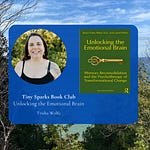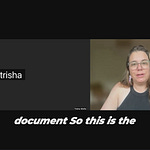Hello Book Club Friends! Wow, I am so loving reading Unlocking the Emotional Brain together! We’re just getting started but I’m having so much fun learning more about the science of transformational change. I know this book can be a bit dense/clinical, so don’t worry too much if it feels like a lot to get through - that’s why I’m here! I love getting to read through the chapters and translate it into real life understanding. Please feel free to leave a comment below and let me know what you’re learning! And scroll wayyyyy down to the bottom for a book club schedule for this book :). It’s a long one but SO worth it!
(0:00 - 2:54)
Hello and welcome back to our read-along of The Emotional-Based Brain. I have been enjoying reading this book so much because it is so exciting when you get to see science backing up everything that you’ve already known. You know, a lot of times psychology and counseling are considered quote-unquote soft sciences, but this book does a great job of delivering the actual hard science results that show why things like therapy work.
So we’ve done a lot of learning together, but this book is actually about unlearning. Oftentimes when we think about healing or changing or moving toward what we want for ourselves in our life, we think about addition. We think about adding awareness, we think about adding tools, we think about adding new habits, though if you’ve listened to me or worked with me, you know I’m not a big fan of trying to control our habits.
But we often tell ourselves we just need to think differently, act differently, choose differently, and of course that’s often part of our underlying strategies, our underlying patterns that we have learned that to show up differently in the world we have to try harder, be better, be perfect, don’t have needs, etc. But Unlocking the Emotional-Based Brain actually talks about unlearning, and that is what chapter two is about. This describes what is probably the most important discovery in the neuroscience of change and healing from trauma, which is the process of memory reconsolidation.
Over the course of the last couple years I’ve been learning more and more about this term, and it wasn’t a term I had heard before then, but it describes something that I already knew and already talked about, which is the idea that we can update these maps in our brain thanks to neuroplasticity and this process called memory reconsolidation. So later on in this book we will be diving into all the different types of therapy like EMDR and IFS and somatic experiencing and looking at how they affect change using this process. But for now we want to learn more about how this process works.
So memory reconsolidation is the process by which the brain can change the impact of old emotional learnings, these old learnings that keep us stuck in shame, in fear, in self-protection, long after the actual danger or the felt sense of danger has passed. As you know if you’ve been in the book club for our past books, we know that especially when we’re children, but when we’re adults too, and we’re existing in environments that are overwhelming, that are too much, that are not enough, we get a sense that we constantly have to be on edge to be trying to protect ourselves, even in situations where a physical danger is not at risk. That is because we are wired to stay in connection to our primary attachment figures, our parents, our caregivers, but as humans we are wired to stay in connection to others as well.
(2:54 - 13:49)
So when we’re young we don’t have the cognitive complexity to understand that our parents aren’t really in danger or that we aren’t really in danger. Instead what we’re feeling is, oh my gosh every time I come home from school and I didn’t get a really good grade or something went a little bit wrong or I made a mistake, I feel a tension in my house. I feel like maybe my parents pulled back from me a little bit.
I feel like I get a little bit less attention or maybe I even get punished or sent to my room. Maybe it’s nothing overt, but it’s just this generalized sense of disappointment. And when that happens repeatedly, what our child brain will learn is that love will be withdrawn if we are not perfect all of the time.
And that could be from our parents, we could experience from our peers, our teachers, and again in our adult life. But when that happens, remember how neural pathways form. They form with frequency and intensity.
So when we have these frequent and intense experiences that create a lot of fear in us as a child, and even anger and sadness too, it creates these neural pathways, these emotional learnings in our brain that create ideas like, if I’m not perfect, I won’t be loved. Remember, emotional learnings are a little bit different from thinking those things, right? They’re a little bit different from this idea of core beliefs, which is things we’re actively thinking. They’re in our unconscious mind.
So maybe you’ve heard this quotation before, that’s not exactly accurate, we could go more into that later, but from Jung that says, until you make the unconscious conscious, it will direct your life and you’ll call it fate. And I think that’s really apt to describe what these emotional learnings are like. They are implicit, they are unconscious, they are below our conscious mind, but unwittingly we are constantly acting out these learnings because we are trying to prevent the loss of connection.
So what memory reconsolidation allows us to do is to isolate these old emotional learnings, isolate these pathways in our brain, and start to change the impact that those learnings have on us in the present by targeting memories or experiences where we first learned those things. So let’s talk a little bit about this process. For most of the 20th century, scientists believed that emotional memories were permanent.
You might be able to suppress them, or change their intensity through exposure or coping, but you couldn’t really erase them because the emotional brain and the amygdala were sort of hardwired. In 2000, they started doing some interesting experimentation that changed this belief. Now I do want to give you a little heads up in this chapter, and thus in this podcast, I’m preparing to discuss some lab experimentation they did with animals, specifically rats, and you know that might not be the best feeling for you, or it might be something that you don’t feel comfortable with, and so you’re more than welcome to skip over this part, and it’s not going to change your fundamental understanding of the book.
So in this lab, they conducted an experiment with rats, and they trained these rats to associate a tone, a sound that they played, with an electric shock. And after several times of doing that, the rats would freeze whenever they heard the tone. So it’s sort of that classical Pavlovian conditioning.
Now what they did then is they reactivated the fear memory by playing the tone just once. So they played the tone, and the rat’s brain activated the memory that said, a shock is going to be coming. And during that short window, they injected a protein synthesis blocker into the rat’s amygdala.
And when the rats were tested again the next day, the fear response was totally gone. And this was the first time the researchers realized that they may be able to deconsolidate a memory that already existed. And they did achieve this chemically, but as they continued to study this, they found that a similar thing could happen through experience, where we could rewrite the emotion of the memory.
And so they learned that they could do this without using chemicals or medication through introducing what is called a prediction error. If you’ve been listening to the other books or you know my work, you know this is something I talk about very frequently, where as we build up that felt sense of safety and that capacity to observe ourselves and the maps or roadways in our brain, eventually we have to introduce what I call congruence experiments, which is where we think about and then eventually try something very small to see what happens that is different from our past experience. So the example that I use a lot is if you have a core learning, an emotional learning that says every time I have a need I am punished or sent away, then we might think about what would happen if you get the wrong drink at the coffee shop and you let the barista know you got the wrong drink and you beg them to remake it.
That is an opportunity for your brain to say, stop, no, that’s dangerous. But we get to introduce a prediction error and say, hmm, is anything dangerous actually going to happen in that moment? Or does anything dangerous actually happen in that moment when you try it on? That’s how we introduce a prediction error to our brain to say, this actually doesn’t hold up with this old emotional learning. And so the studies continue to bear this out that that prediction error or that mismatch experience could change these emotional learnings.
They could erase the fear or whatever other emotions might be coming along. So if we think of our brain of that map with all of those roads and many of those roads are coded in safety, they say this is what I have to do to stay in connection and not get voted off the island. And it might hold learnings like if I cry or show emotions, people will withdraw from me.
If I’m quiet and I take care of other people’s needs, I am loved. If I do well, I am loved. Those are all those roadways, those beliefs stored inside your map.
But these maps don’t automatically update. Unlike our GPS in present day, they don’t automatically update just because we become adults or we leave the difficult situation. Those old, very charged learnings are still in there.
Memory reconsolidation is part of the process that allows us to redraw those routes and to find new routes that are actually safe. So let’s talk about the unlearning sequence. Step one is reactivation.
And so we have to actually bring that learning online and as an experiential way. That’s why we often focus on experiential therapies when we’re working with things like complex PTSD or childhood trauma or people who are just really stuck. We need an experiential modality where we’re not just talking about it, but we’re experiencing it.
We’re activating that old learning. And so when we bring up that emotional learning in the present, we know that it opens a window. This is what they’ve shown in many studies.
It opens a window where that memory becomes changeable. It becomes editable, essentially. Imagine we reach into the filing cabinet of your brain.
We pull out one of the folders that is bright red and says, safety, safety, safety. So we pull out one of these folders that hold one of your learnings around safety. And we want in the moment for you to truly be able to connect to the emotions of that experience because it is the emotion that creates the learning in the present.
Then we introduce that mismatch, that prediction error, like we talked about. We introduced the time when you said your drink needed to be remade and nothing dangerous happened. We know that when the emotional learning is activated and being experienced in the moment and we introduce this contradiction, that is when it is changeable.
Listen to this episode with a 7-day free trial
Subscribe to tiny sparks - trisha wolfe to listen to this post and get 7 days of free access to the full post archives.










